Bestial experiments in the name of science. Torture forced by the vision of progress. But also - inhuman trials carried out out of sheer cruelty. The kind where the victims weren't even considered human. The unfortunates were merely "logs".
Japan's expansion in Asia began with Manchuria. It was there, in the 1930s, that the imperial army created the first laboratory in which Chinese prisoners were to be "guinea pigs".
It was about research into chemical and biological weapons. The candidate for the head of this center seemed obvious. This is Shiro Ishii, a doctor and microbiologist who spent the previous few years traveling around Europe. There he looked at the effects of using war gases in the First World War. Tokyo power circles were already dominated by militarists at the time, and Ishii easily convinced the minister of war to join the WMD program.
The first laboratory was established in the Hong Ma camp, in a deserted town near Harbin (the largest city in Manchuria). In 1936, Ishii, promoted to colonel, had enough resources and influence to launch a large research complex. It was created in the village of Pingfan near Harbin.
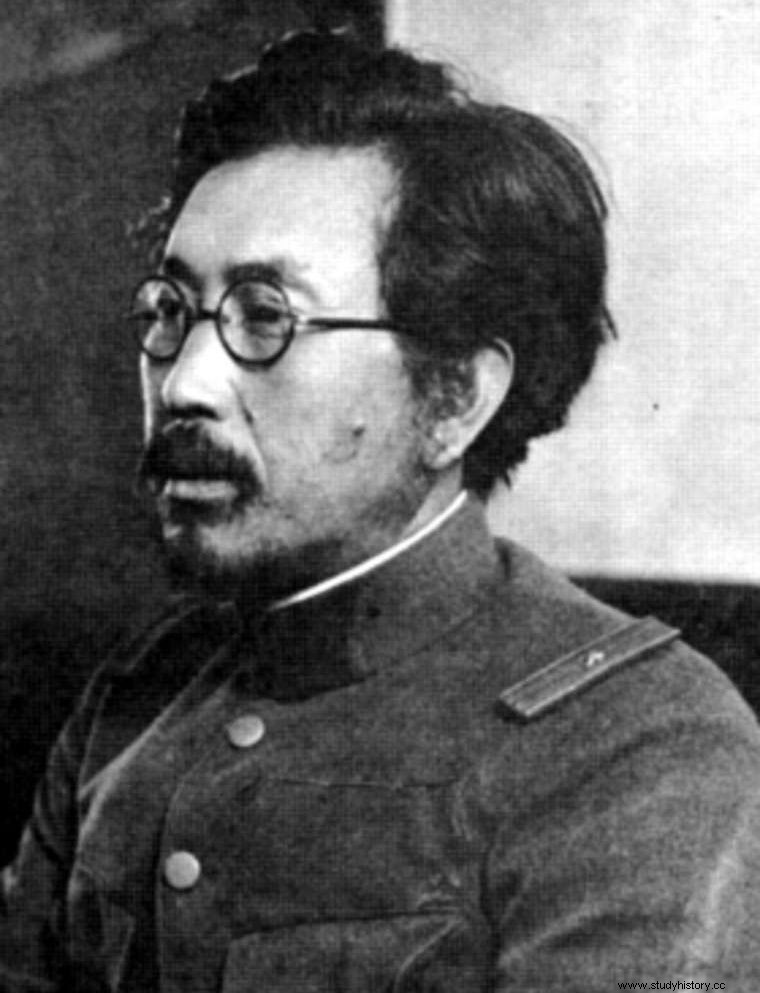
Shiro Ishii, a doctor and microbiologist, easily convinced the Minister of War to join the WMD program. The research program included experiments on humans (photo:Masao Takezawa, source:public domain).
In an area of several square kilometers, isolated by walls and barbed wire, the Japanese built a laboratory, a prison pavilion, a chemical and bacteriological weapons factory, and a crematorium furnace. Ishii also had at its disposal a training ground for field exercises and a squadron of airplanes with pilots.
Scientific elite in the service of crime
Until 1941, the center operated under the official name of "the department of epidemic prevention and water purification of the Kwantung Army" . Then he got a code name that still evokes ominous connotations:Unit 731.
Ishii gathered an elite of doctors and scientists drawn from Japanese universities, as well as civilian employees - a total of several thousand people. Through various departments, they were expected to grow and produce infectious disease germs , conduct laboratory and field tests, as well as test the means of delivery (aerosols, special porcelain aerial bombs).
The center in Pingfan was not the only one - others are being created, incl. near Nanjing, Changchun (then Xinjing), even in Singapore. All of them unscrupulously used humans as guinea pigs. After the war, one of the Japanese officers tried by the Soviets in the so-called in the Khabarov trial, he said: I know that as long as there was a prison in Unit 731, none of the prisoners left it alive.
"They were just pieces of meat"
The laboratories of Unit 731 were sent to prisoners of war (mainly Chinese, but also Soviet and Korean), alleged spies, but also ordinary civilians, arrested and delivered to centers by contingents by the Kempeitai - Imperial Secret Service.
Japanese expansion in Asia was saturated with extreme cruelty from the very beginning. The army, from private to general, was nourished on the one hand by the cult of absolute subordination, on the other hand, it was permeated with contempt for life. Both own soldiers and civilians in the conquered areas. Murders, rapes, looting, forced slave labor, dehumanization of prisoners of war and civilian victims - all this was on a massive scale.
In Unit 731 and similar centers, the victims were referred to as maruta - "Logs", "blocks of wood". They were losing names and surnames. They became numbers, which made it easier for the perpetrators not so much to record as to describe experiences. “They shouted and shouted. We did not consider these "logs", these "blocks", as human beings. They were just pieces of meat to be cut into a stump "- reported an eyewitness to the experiments.
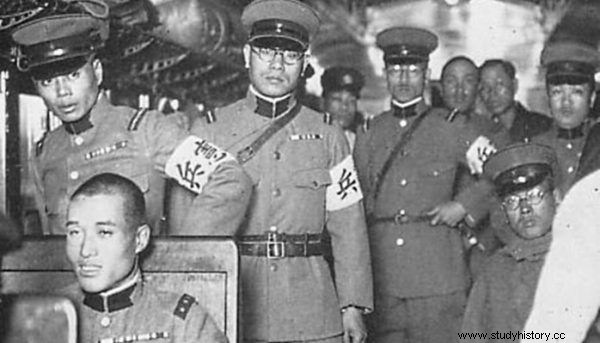
Kampeitai was responsible for bringing people to the laboratory for experiments. In this photo from 1935, her gendarmes are traveling by train (source:public domain).
The criminal imaginations of Japanese scientists knew no bounds. Even if some of these experiments could be justified by scientific or military needs, most of them served only to satisfy the sadistic tendencies of their organizers.
Rats, fleas and the sound of the chopping board
Prisoners in Pingfan were implanted with germs:cholera, typhus, and plague. Years later, civilian workers who administered the injections said that prisoners infected with the plague were thinning their eyes for a few days and their skin turned almost black. In order to test and strengthen the virulence of individual strains, the sick were infected with one another. If someone recovered, they would have to be tested again until they died.
Trials were also conducted at the training ground. They consisted in the fact that a dozen or so prisoners were tied to stakes somewhere in the field, and then bombs with fleas carrying the disease virus were dropped on the area. In order to craft such a weapon, it was first necessary to prepare a culture of thousands of infected rats on which fleas could parasite.
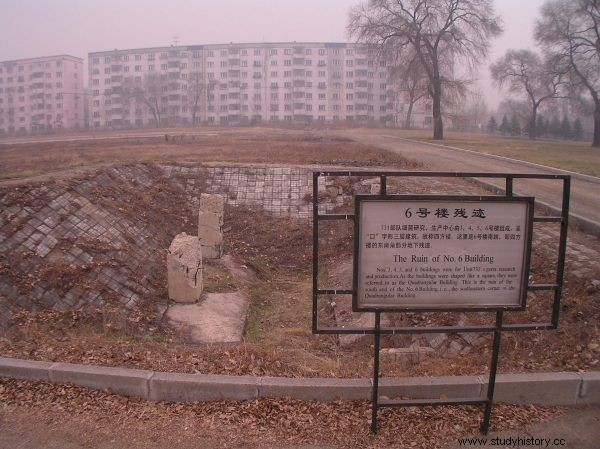
Remains of the Harbin building number 6, where bacteriological weapons were developed (photo 松岡明 芳, license CC BY-SA 3.0).
Another test involved wounding the victims with shrapnel from a bomb "infected" with gas gangrene - the mutilated died in torment within a week.
Women were impregnated and then fetuses were removed at different stages of pregnancy. They were also infected with syphilis during pregnancy and watched as the disease progressed. Fire disinfection devices were tested on live humans.
Internal organs were cut out to check without which a person could survive and for how long. Humans were left in a 40-degree frost to freeze their limbs (until they "made a sound like a wooden board" on impact), and then tried various ways to defrost them.
Criminal doctors and hospital torture rooms
The surgeons amputated the victim with both hands and sewed the left one into the place of the right one to see if the transplant was successful. People were injected into their kidneys with horse urine, enormous amounts of animal blood were transfused, electrocuted, irradiated with X-rays, and exposed to mustard gas.
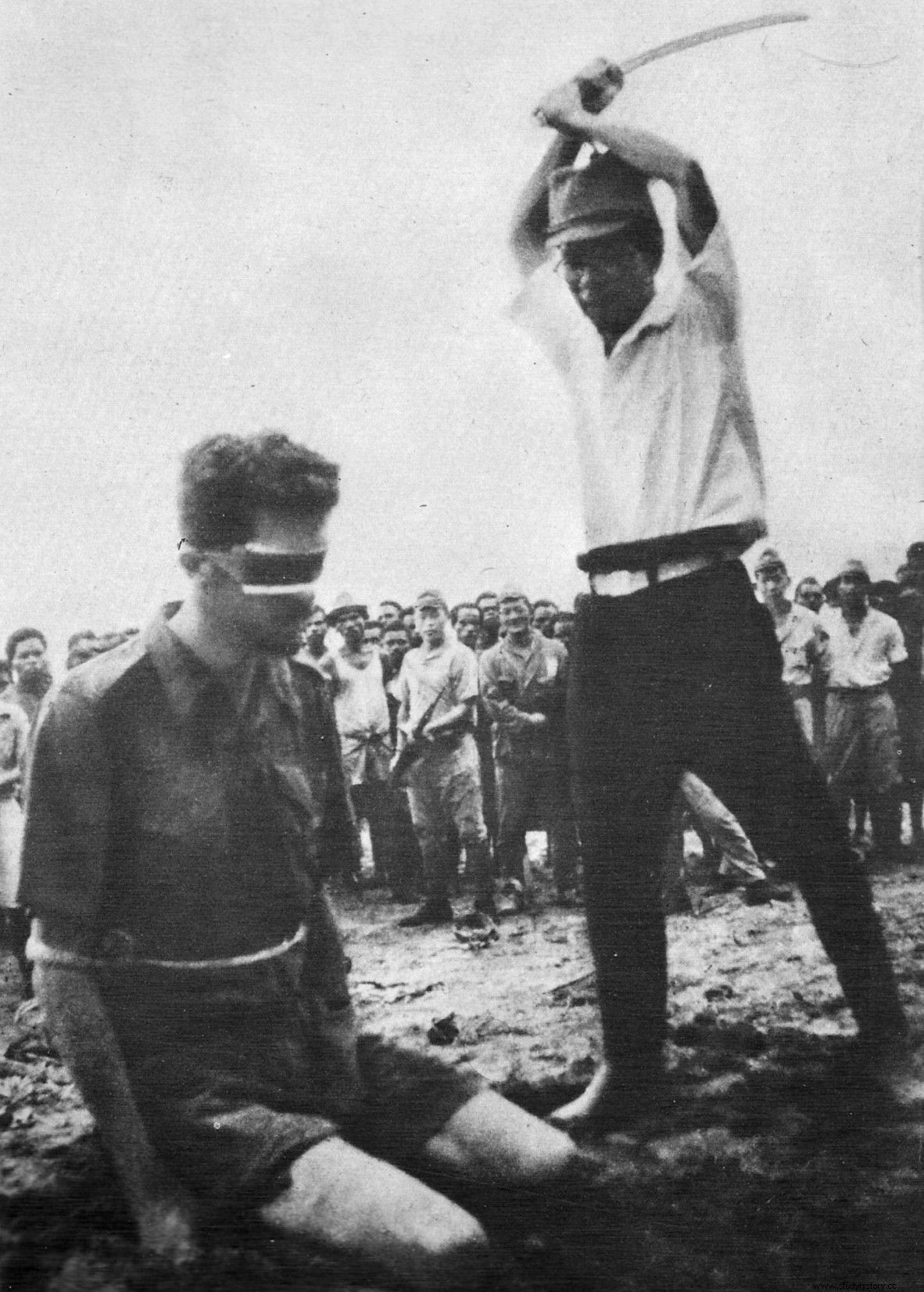
Battered human "logs" were deprived of life, among other things, by cutting. The photo shows the Australian commando, Sergeant Leonard G. Siffleet, just before the fatal blow inflicted by the Japanese Yasuno Chikao in October 1943 (source:Collection Database of the Australian War Memorial, public domain).
One experiment was that two people for weeks only got biscuits and water, and they were not allowed to sleep, but they were supposed to carry 20 kg bags of sand. The experience lasted about two months (...). They couldn't survive any longer One of the witness-nurses recalled. Such methods were used to check how long it takes for a person to die of hunger, dehydration, cold or lack of sunlight.
Vivisections went beyond the wires of secret centers. Some were justified by the need for accelerated training of field doctors. In hospitals, surgeons on living, sleeping Chinese demonstrated how to excise the appendix, amputate a limb or remove a part of the intestine. It happened that "objects" were shot in the abdomen at various distances, and then the bullet was removed without anesthesia. The battered "logs" were finally beaten to the heart with an injection or their heads were cut off with a sword.
On a smaller scale, experimented also with American pilots and captured sailors. Some were injected with malarial blood, others were administered unknown toxic substances. In Mukden, nearly 1.5 thousand people fell victim to such practices. Allied POWs. Some survived - and the case of the Japanese murderous experiments only became louder in the world when they started talking about it after many years.
Gase and burn, that is, obliterating traces
The Japanese tried to use biological weapons during fights with the USSR, incl. infecting the river flowing towards the border with typhus and cholera sticks. They also used it against the Chinese - it is known about the case when, before their own retreat, contaminated the ground with anthrax germs but the epidemic also reached their troops. Cotton chaff and rice husks infected with the plague were also dumped over Chinese villages, resulting in local epidemics.
However, they were preparing for an operation on a much larger scale. Plague flea bombs were to be used against the Allied defenders of the Bataan Peninsula in the Philippines. However, they gave up without it. Bacteriological weapons specialists and the weapon itself were sent to Saipan just before the American invasion, but their ship was torpedoed. It was thought to dump biological loads, incl. for Australia and India.
Cruel experiments were also carried out when the defeat of the Empire was more than obvious. When nuclear bombs fell on Hiroshima and Nagasaki and Soviet troops moved to Manchuria, the command of Unit 731 proceeded to obliterate the traces of its activities in Pingfan.
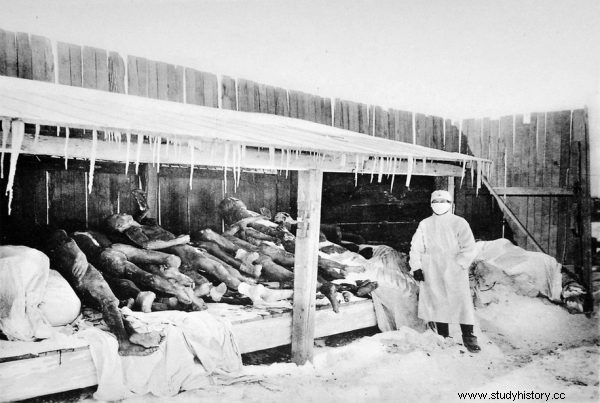
Almost all the photos showing the atrocities of the Japanese Death Doctors have been destroyed. It is no wonder then that this photo of the Manchurian plague victims at the turn of 1910 and 1911 has long been presented as a repository for the bodies of Unit 731 (source:public domain).
The personnel was evacuated, some buildings were blown up, and the survivors of prisoners were gassed. Officers and scientists fled south, trying to reach Japan quietly through Korea. A similar scenario was followed by other secret centers.
Criminals destroyed photo and document evidence, but a lot survived. Some did not manage to escape from the Soviets. After a few years, they organized the aforementioned trial in Khabarovsk. The former commander of the Kwantung Army and several other officers and scientists were given 25 years each.
Secrets, Immunities and Careers
The Americans had other plans for the members of Unit 731. During the Tokyo trials (the Asian equivalent of Nuremberg) no word was mentioned about them. They were given immunities by General MacArthur, who in practice ruled post-war Japan, which was the price for giving their testimony and making the surviving research results available. It did not even impress MacArthur that American soldiers were also victims of the experiments.
Tokyo became a Cold War ally of Washington and for years both capitals kept the secret of the bestial experiences of the war in solidarity. The Japanese government admitted that they were carried out only in the 1980s.
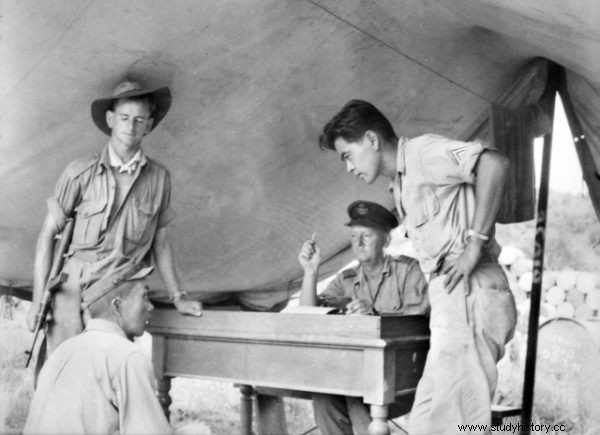
Due to post-war cooperation between Japan and the US, most of the people who conducted experiments escaped punishment. Pictured is the hearing of a Kempeitai member in Borneo in October 1945 (photo:Frank Albert Charles Burke, source:Australian War Museum Image No. 121782, public domain).
The commanders and physicians associated with Unit 731 and similar centers made careers in post-war Japan. One of them headed the national medical association, many received awards at home and abroad. For example, Masaji Kitano - Ishi's deputy in command of Unit 731 during the war - became one of the most important figures of the pharmaceutical giant Green Cross.
It is not known exactly what happened after the war with Shiro Ishi. Some sources indicated that in Maryland he helped Americans with biological weapons development others said he ran a clinic in Japan. It is known for certain that neither he nor any of the Japanese "doctors Mengele" had a hair off his head after the war.
